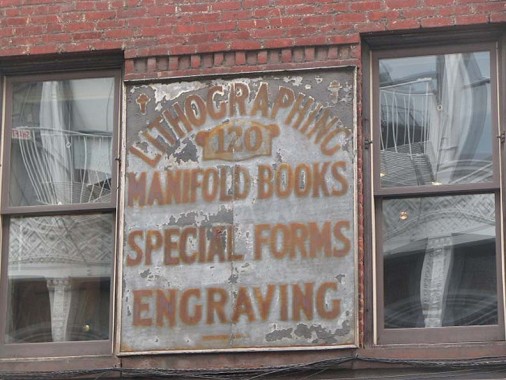Soho’s Prince Street runs west from the Bowery to 6th Avenue at Macdougal and Charlton Streets. In the pre-Revolutionary era, there were a number of streets named for the British royalty, such as Queen, Duke, etc, and most eventually were renamed– but not Prince, making this street an interesting pre-Revolutionary relic. (King Street is named for US Senator, diplomat, and unsuccessful vice-presidential and presidential candidate Rufus King (1755-1827) whose mansion in Jamaica, Queens, still stands.)
On weekends Prince Street tends to be a maelstrom of activity as it’s a main shopping and boutique row. Crowds jam the original Apple Store, in a former post office at Prince and Greene, and the historic Fanelli’s Cafe at Mercer has been a drinking establishment since the 1840s.
120-126 Prince is a low, 2-story building that looks as if it goes back to the days when what would become Fanelli’s first opened–perhaps even older than the 1840s. At 124 Prince is the Morrison Hotel Gallery (I believe there is another one at The Bowery and Bleecker). Its logo is reminiscent of The Doors’ classic Morrison Hotel LP cover. The band had propitiously found an actual Morrison Hotel at 1246 South Hope Street in Los Angeles. The actual Morrison Hotel closed in 2007.
A long time ago, the building had apparently been a paper distributor. A pair of metal signs that are, perhaps, over a century old can still be found there.
Manifold paper, in the days before Xerox and modern copy machines, was a lightweight paper used with carbon paper to make multiple copies. “Special forms”, as far as I gather, were used in tax preparation.
Engraving is the practice of incising a design on to a hard, usually flat surface, by cutting grooves into it. The result may be a decorated object in itself, as when silver, gold, steel, or glass are engraved, or may provide an intaglio printing plate, of copper or another metal, for printing images on paper as prints or illustrations.wikipedia
Lithography (the practice of drawing on limestone with waxy crayons to create a master image that absorbed ink) was introduced in the United States in the early 1800s … publishers used lithography as an inexpensive alternative to engraving and avoided the expense of multiple presses by lithographing both illustration and text. Past is Present
Modern computerized methods of printing may be more convenient, but we have certainly lost a sense of craft. Will this knowledge be available in future generations?
Photographed May 2010; page completed May 26, 2010




2 comments
I remember Bridge St (near Fulton) in downtown Brooklyn used to have some wonderful stores 40 years ago – a bookstore, a notions store, maybe even a fabric store. They were right on the block where the M train station was (or whatever designation the local Brighton line had at that point). Does anybody know what happened to these stores?
Re your attributions to 120 – 126 Prince Street…to set the record straight; 120 Prince Street was from the early 1900’s to approximately 1950 the home of Herman Leff Printing & Stationery. It was named for my father’s uncle. My father, Irving Schreiber, and his two brothers Sol & Manny worked together there for more than 40 years. I joined the family business from 1962 – 1969. My father closed the business in 1970. The stationery store was at 120 Prince St. The print shop took up the entire upper floor (to the corner of Wooster St.) Barney Spina’s luncheonette was at #122 and Frank Valenti’s barber shop at #124. Incidentally, “special forms” meant nothing more than multi-form books, such as invoices, restaurant checks, etc.. Those 2 signs mean a great deal to me, as they were part of my childhood & adult years. Would appreciate any feedback to this “history lesson”.
Steve Schreiber